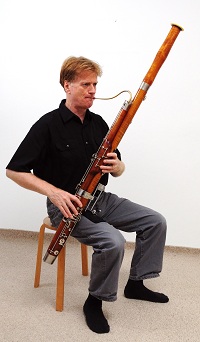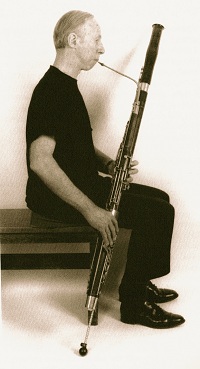About Bassoon Playing
The following is an edited extract from a chapter about bassoon playing written by Michael Parkinson for Elizabeth Langford's book: Mind, Muscle and Music (ISBN 978 90-808491-3-6), which is the sequel to her first book Mind and Muscle - An Owner's Handbook (ISBN 978 90-441-2267-1).

"When I first started learning to play the bassoon at the age of 12 in the early 60's, the traditionally accepted way to support the instrument was with a neck-strap or 'sling'. Having the instrument suspended in this way, almost the entire weight of the bassoon tends to pull the neck and torso forwards and downwards. Much effort is also needed by left hand and arm to prevent the bassoon pitching forwards. This had a catastrophic effect on my general body posture; perhaps even more so whilst sitting as it´s tempting to give in to this constant downward pull and simply collapse into the chair. In any event, the constant weight imposed on the neck and torso is almost certain to drag all but the ´beefiest´ player down in front, pushing the ribcage into a compressed abdomen. If this happens one can reasonably expect to see a tightening of the neck muscles and a retraction of the head. In my case the tension in the muscles at the back of my neck was extreme, causing uncontrollable sideways twitching of the head!
Despite the obvious drawbacks of playing with a neck-strap there are a number of players who still use this set-up and seem to cope reasonably well. A recent variation on this method which has long been favoured by saxophone players is a type of body-harness from which the instrument is suspended. The harness helps distribute the weight of the instrument more evenly on the torso with less direct pull on the neck. This is possibly a better option for playing whilst standing. But one still has to carry the entire weight of the instrument with the torso (and legs in standing), so most bassoon-players today have opted for other systems which lend themselves to a better overall use of ourselves.

William Waterhouse demonstrating the use of a spike to support the bassoon. Note the re-shaped crook.
One example is an adjustable metal spike, which allows the bassoon to be rested on the floor. The spike is fitted to the lower end of the bassoon; just like those fitted to cellos and basses. The bassoon leans against the right thigh and only a minimal amount of effort is needed with the hands and arms to steady the instrument. I believe this system was first instroduced in Britain by William Waterhouse, and was soon to be adopted by many other players. I changed from a sling to a spike when I started music studies at the Guildhall School of Music in London, and was quite happy with it for some years. My main dislike of this method was that the instrument tended to be rather more upright than with the sling. Although the spike eliminated the weight in the left hand, people like me with relatively short fingers find that they have difficulty reaching the keys with the little finger on the right hand, and this can cause a lot of tension in the right wrist and shoulder. Of course, this can be remedied by having the keys extended or re-shaped by a skilled instrument repairer to suit the players´ hands. The shape of the crook can also be changed, which is almost always necessary when changing to a spike. Modifying or even removing the handrest can also give the right wrist more freedom, but it can take a while to get used to playing without one altogether.
A recent variation of the spike is called the 'Vonk'; named after it's designer Maarten Vonk in Holland. A single spike has been replaced by a 3-legged stand which also attaches to the lower end of the bassoon. In this case the bassoon is entirely self-supporting, and the player carries no weight with the body or arms. Bassoonist John Orford in England has developed a similar system. Not having tried these methods I cannot comment, but the concept is very appealing.
The method favoured by most players that I know is the seat-strap. This is basically a leather or material belt with a hook on one end. The player sits on the strap and the hook is attached to the lower end of the bassoon. This set-up gives one perhaps the best of both worlds, as it does not change the angle of the bassoon quite so much, but takes all the weight off the neck and torso. Depending on the angle of the instrument it does still leave a considerable weight in the left hand to stop the bassoon pitching forwards, but usually less so than the sling. Many players argue that having some weight in the left hand gives the feeling of having more security and control over the instrument. I understand this feeling very well from my own experience, but with all such changes one needs time to adapt.

Finally we come to what I consider to be the best of the methods I have tried; the Dutch leg support. This is a system created by bassoonists in Holland, and is used by many of the players there today, and indeed elsewhere. This is not so easy to describe in words, and therefore I refer readers to the picture to the right. Almost the entire weight of the bassoon rests on one´s upper right leg. There is a universal joint between a padded plate that sits on the upper leg and the metal arm that connects this to the body of the bassoon. This means that the player can move the instrument around at will in all directions. The height of the instrument can also be adjusted quickly with a simple screw mechanism. Opponents tell me that the weight on the thigh can get too much after some time, but I only discovered this method after having stopped playing professionally, so far be it from me to deny this without having had the experience. I do play regularly in amateur orchestras and chamber music however, and so far this has not been a problem. It is worth considering that older bassoons like mine which were built 50 or more years ago can be considerably lighter than modern instruments which are more substantially built and often have many more keys than older models which all add to the overall weight. Perhaps this is one reason why players of previous generations were more content to play with a neck-strap.
It is important to remember that as individual human beings we are all very different, and that what one person considers to be the ideal way to hold a particular musical instrument will not necessarily suit all. The secret is maybe not to get stuck with one way and experiment as much as circumstances will allow. There is no 'right' way to hold the bassoon, but if we can improve the way we use ourselves in general as described throughout Mind and Muscle, perhaps a way to hold the instrument that allows one to play with more freedom and less strain will reveal itself. Playing in a professional orchestra can be tough going at the best of times, so experimentation might best be done when the workload is not so demanding. It must also be emphasised that one cannot buy good 'use', and just as a so-called 'good chair' cannot save us if our use in sitting is poor, none of the methods described above can do for us what our brains needs to be doing: thinking in activity!"
Photograph of William Waterhouse by Edward Webb
|
The Alexander Technique Centre Vienna
Director: Michael Parkinson
Franzensgasse 5/47
1050 Vienna
Austria
Email:
michaelcparkinson@gmail.com
Mobile:
0043 (0)676 941 4212

|




